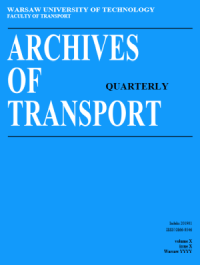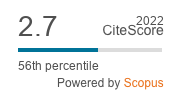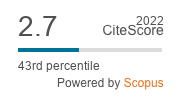Optimisation of the railway transition curves' shape with use of vehicle-track dynamical model
DOI:
https://doi.org/10.2478/v10174-010-0024-zKeywords:
optimisation, numerical simulation, transition curves, railway vehicle dynamics, vehicle-track interactionsAbstract
The concept and the method by present authors of searching for proper shape of transition curves are described in present paper. Short literature survey provides a background for such description. In the concept and method the advanced dynamical model of vehicle-track system, capable of simulation, and mathematically understood optimisation methods are exploited. Polynomial transition curve of any order can be optimised with the method proposed. Components of angular velocity and acceleration of transportation are presented for such curve in the paper. Thanks to them kinematical properties of the curve are represented in precise way in the dynamical model. As concerns the method, its principles and the most important details are discussed in the paper. Information about the method is extended by description of the software built to carry out the curve formation (optimisation) effectively. At the end, examples of the results generated by this software are presented and discussed.
References
Woźnica P., Zboiński K.: Analiza literatury krajowej i światowej dotyczącej modelowania krzywych przejściowych z naciskiem na metody komputerowe. ILiM, Logistyka, nr 6, 2009, CD Logistyka - nauka; Railway Transport (CD is the integral part of the issue 6/2009).
Baykal O.: "Concept of Lateral Change of Acceleration", Journal of Surveying Engineering, 122(3), 132-140, 1996.
Tari E., Baykal O.: "A New Transition Curve with Enhanced Properties", Canadian Journal of Civil Engineering, 32(5), 913-923, 2005.
Ahmad A., Ali J.: "G3Transition Curve Between Two Straight Lines", Proc. 5th CGIV'08, 154-159, IEEE Computer Society, New York, 2008.
Tanaka Y.: "On the Transition Curve Considering Effect of Variation of the Train Speed", ZAMM - J. of Applied Mathematics and Mechanics, 15(5), 266-267, 2006.
Ahmad A., Gobithasan R., Md. Ali J.: "G2 Transition Curve Using Quadratic Bezier Curve", in "Proceedings of the Computer Graphics, Imaging and Visualisation Conference", 223-228, IEEE Computer Society, 2007.
Li Z., Ma L., Zhao M., Mao Z.: "Improvement Construction for Planar G2 Transition Curve Between Two Separated Circles, in V. N. Alexandrov et al. (Editors), ICCS 2006, Part II, LNCS 3992, 358-361, 2006.
Habib Z., Sakai M.: "G2 Planar Cubic Transition Between Two Circles", International Journal of Computer Mathematics, 80(8), 957-965, 2003.
Fischer S.: "Comparison of Railway Track Transition Curves Types", Pollack Periodica - An International Journal for Engineering and Information Sciences, 4(3), 99-110, 2009.
Tari E., Baykal O.: "An Alternative Curve in The Use of High Speed Transportation System", ARI - An International Journal For Physical and Engineering Sciences, 51, 126~135, 1998.
Long X.Y., Wei Q.C., Zheng EY.: "Dynamic Analysis of Railway Transition Curves", ProcIMechE, Part F: Journal of Rail and Rapid Transit, 224(1), 2010, DOI 10.1243/09544097JRRT287.
Kuvfer B.: "Optimization of Horizontal Alignments for Railway - Procedure Involving Evaluation of Dynamic Vehicle Response", Ph.D. Thesis, Royal Institute of Technology, Stockholm, 2000.
Koc W., Mieloszyk E.: The Comparing Analysis of Some Transition Curves Using the Dynamic Model, Archives of Civil Engineering, 33(2), 239-261, 1987.
Zboiński K.: "Numerical Studies on Railway Vehicle Response to Transition Curves with Regard to Their Different Shape", Archives of Civil Engineering, XLlV(2), 151-181, 1998.
Droździel J., Sowiński B.: "Railway Car Dynamie Response to Track Transition Curve and Single Standard Turnout", in "Computers in Railways X", J. Allan et.al. (Editors), 849-858, WIT Press 2006.
Pombo J, Ambrosio J.: "General Spatial Curve Joint for Rail Guided Vehicles: Kinematics and Dynamics", Multibody System Dynamics, 9(3), 237-264, 2003.
Kufver B., Forstberg J.: "Dynamic Vehicle Response Versus Virtual Transitions", Computers in Railways IX, WIT Press, 799-807, 2004.
Esveld C.: "Modern Railway Track", MRT-Productions, Duisburg 1989
Zboiński K: "Railway Vehicle-Track Model in Its General Conception", in "Advanced Railway Vehicle System Dynamics", J. Kisilowski, K Knothe, (Editors), WNT - Science and Technology Publishers, Warsaw, Poland, 29-56, 1991.
Koc W.: "Transition Curves with Nonlinear Superelevation Ramps in Exploitation Conditions of PKP", Scientific Bulletins of Gdańsk University of Technology - Civil Engineering, 47, 1990.
Zboiński K: "Importance of Imaginary Forces and Kinematic Type Nonlinearities for Description of Railway Vehicle Dynamics", Proceedings of the Institution of Mechanical Engineers, part F, Journal of Rail and Rapid Transit, 213(4), 199-210, 1999.
Zboiński K.: "Relative Kinematics Exploited in Kane's Approach to Describe Multibody Systems in Relative Motion", Acta Mechanica, 147(1-4), 19-34,2001.
Zboiński K.: "Numerical and traditional modelling of dynamics of multi-body system in type of a railway vehicle", Archives of Transport, 16(3),81-106,2004.
Downloads
Published
Issue
Section
License
Copyright (c) 2023 Archives of Transport journal allows the author(s) to hold the copyright without restrictions.

This work is licensed under a Creative Commons Attribution 4.0 International License.











